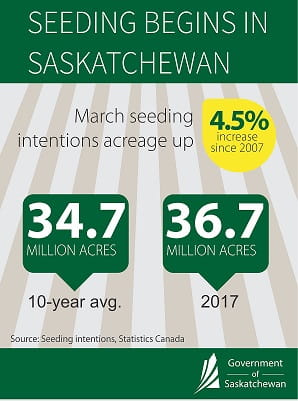Released on May 4, 2017
Saskatchewan farmers are slowly making their way into the field. Adverse weather has delayed spring field work, such as applying herbicide, harrowing and seeding, in some areas. Many fields remain wet. Warm and dry weather will be needed in the coming weeks before seeding can get fully under way.
The majority of producers with crop from last year still in the field have, so far been, unable to finish harvesting due to cool weather, wet field conditions and lodged crops. It is estimated that approximately one million acres of the 2016 crop remains in the field, with the majority being in the west-central and northeastern regions of the province. There was little harvest activity over the winter months in these areas, and spring progress has been very limited. Aeration bins and grain dryers have been in continuous operation on many farms since last fall.

Despite these challenges, some producers in the south of the province have begun seeding pulses and cereals. One per cent of the provincial crop is in the ground, compared to the five-year (2012-2016) seeding average for this time of year of six per cent. In the southeast, producers are reporting that three per cent of the crop is seeded, while in the southwest, producers have two per cent seeded. There is very little, if any, crop seeded in the other areas of the province.
Much of the province received large amounts of precipitation over the last month, and fields remain wet in many areas. Provincially, cropland topsoil moisture is rated as 30 per cent surplus, 69 per cent adequate and one per cent short. Hay land and pasture topsoil moisture is rated as 16 per cent surplus, 81 per cent adequate and three per cent short.
Producers are busy seeding, calving, controlling weeds, working fields and trying to wrap up last year’s harvest.
A complete version of the Crop Report is available online at www.publications.gov.sk.ca/redirect.cfm?p=85206&i=98692.
Follow the 2017 Crop Report on Twitter at @SKAgriculture.
-30-
For more information, contact:
Shannon Friesen
Agriculture
Moose Jaw
Phone: 306-694-3592
Email:
shannon.friesen@gov.sk.ca
